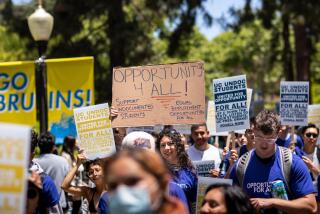2 Dioceses in Contrast on Latino Outreach : Immigrants: San Diego has been more muted than Los Angeles, but a new focus is expected after a change in leadership.
SAN DIEGO — Roman Catholic bishops often vary in their approaches to issues, but on the question of immigration the contrasts between church leaders in San Diego and Los Angeles have been vivid.
In Los Angeles, Archbishop Roger M. Mahony has reached out extensively to the Spanish-speaking immigrant community, even holding a huge Mass in their honor at Dodger Stadium in 1986. Mahony, who speaks fluent Spanish, has been at the national forefront of immigrant issues, openly criticizing U.S. immigration policies.
San Diego does not have nearly the Spanish-speaking population of Los Angeles, but it is estimated that Latinos constitute one-quarter to one-half of all Catholics in the area. Moreover, the region has become perhaps the world’s busiest migratory corridor, traversed by hundreds of thousands of legal and illegal immigrants annually--the great majority of them Spanish-speaking and Roman Catholic.
But, in contrast to Mahony, Bishop Leo T. Maher, spiritual leader of the church in San Diego for two decades, has not pronounced a direct church mandate on the issue of immigration. Instead, he has largely remained in the background.
“There has not been from Bishop Maher a very overt effort on behalf of the immigrants,” said Ozvaldo Venzor, an Encinitas Catholic who heads a group called Friends of the Undocumented.
For his part, Maher said he is thoroughly committed to the migrant issue, but he noted that the church faces financial limits. He denied that he has been unresponsive.
“I think we’ve done a super job,” Maher said. “We’re trying to do it parish by parish; that’s where the action is. . . . We’re doing the best we can. I don’t think there’s anything else we can do right now. . . . If you want to satisfy everybody, you have to be Christ himself.”
The diocese’s focus could be different after July 1 when Bishop Robert H. Brom is scheduled to succeed Maher, who will reach the retirement age of 75.
Brom has already signaled some changes. For example, at ceremonies marking his appointment last summer, the former bishop of Duluth, Minn., spoke partly in Spanish and stressed the importance of Latinos. He also appears less interested in pomp and ceremony than Maher; he has been living in an apartment, eschewing a diocese-purchased, half-million-dollar home. Brom is in Mexico studying Spanish. Maher has limited command of the language.
In San Diego, observers said Maher’s ambivalent approach to the immigration issue has meant that the church’s vast resources have often been channeled in other directions--the much-publicized St. Vincent de Paul Joan Kroc Center for the homeless being a notable example--and not directed to migrants. And, with the exception of several activist parishes, lay people and clerics alike have generally felt little urgency to become engaged with the immigrant community.
If local priests and parishioners want to get involved in migrant-assistance issues--conducting Masses, food giveaways and other activities in the fields--the bishop has not gotten in the way. But he has not been “front and center on immigration,” in the words of one Carlsbad Catholic who has been active on behalf of migrants.
A number of parishes--notably St. Patrick’s in Carlsbad, Mission San Luis Rey in Oceanside and Our Lady of Mt. Carmel in Rancho Penasquitos--have been quite active in assisting the thousands of homeless migrant workers who live in northern San Diego County. But “it’s pretty much on a parish-by-parish basis,” said Father Douglas Regin, pastor of St. Francis Church in Vista who served for nine years as executive director of Catholic Community Services, the church’s social service arm. “I would say that the bishop does not have an extensive outreach program for migrant workers.”
Even Maher’s detractors credit Catholic Community Services with considerable success during its 1987-88 sign-up of about 27,000 amnesty-seeking undocumented immigrants, a number that accounts for more than one-quarter of all legalization applicants in San Diego and Imperial counties. That program, however, is almost exclusively funded by grants and fees and not by diocesan money.
Regarding the plight of migrant field hands in North County, the bishop noted that last April 28 he issued a statement bemoaning their “deplorable” conditions and urging Catholics to help.
But Venzor and others said that Maher’s commentary, which came after both the U.S. Council of Bishops and the Vatican expressed concern about migrant workers worldwide, was long overdue, considering the massive scope of the problem within the diocese and the growing tensions in some areas. The issue of migrants has become so visible to the church hierarchy, in fact, that Pope John Paul II is considering visiting Tijuana during his scheduled trip to Mexico next year.
More to Read
Sign up for Essential California
The most important California stories and recommendations in your inbox every morning.
You may occasionally receive promotional content from the Los Angeles Times.










